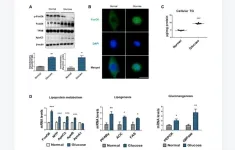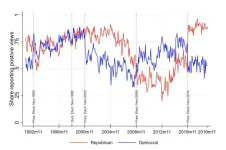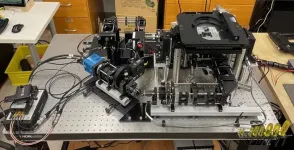(Press-News.org)
“These results suggest strong potential for clinical use of the assay in ctDNA monitoring of solid tumor cancers.”
BUFFALO, NY- March 20, 2024 – A new research paper was published in Oncotarget's Volume 15 on March 14, 2024, entitled, “Analytical validation of NeXT Personal®, an ultra-sensitive personalized circulating tumor DNA assay.”
In this new study, researchers Josette Northcott, Gabor Bartha, Jason Harris, Conan Li, Fabio C.P. Navarro, Rachel Marty Pyke, Manqing Hong, Qi Zhang, Shuyuan Ma, Tina X. Chen, Janet Lai, Nitin Udar, Juan-Sebastian Saldivar, Erin Ayash, Joshua Anderson, Jiang Li, Tiange Cui, Tu Le, Ruthie Chow, Randy Jerel Velasco, Chris Mallo, Rose Santiago, Robert C. Bruce, Laurie J. Goodman, Yi Chen, Dan Norton, Richard O. Chen, and John M. Lyle from Personalis, Inc. describe the analytical validation of NeXT Personal®, an ultra-sensitive, tumor-informed circulating tumor DNA (ctDNA) assay for detecting residual disease, monitoring therapy response, and detecting recurrence in patients diagnosed with solid tumor cancers.
“NeXT Personal uses whole genome sequencing of tumor and matched normal samples combined with advanced analytics to accurately identify up to ~1,800 somatic variants specific to the patient’s tumor.”
A personalized panel is created, targeting these variants and then used to sequence cell-free DNA extracted from patient plasma samples for ultra-sensitive detection of ctDNA. The NeXT Personal analytical validation is based on panels designed from tumor and matched normal samples from two cell lines, and from 123 patients across nine cancer types. Analytical measurements demonstrated a detection threshold of 1.67 parts per million (PPM) with a limit of detection at 95% (LOD95) of 3.45 PPM. NeXT Personal showed linearity over a range of 0.8 to 300,000 PPM (Pearson correlation coefficient = 0.9998). Precision varied from a coefficient of variation of 12.8% to 3.6% over a range of 25 to 25,000 PPM. The assay targets 99.9% specificity, with this validation study measuring 100% specificity and in silico methods giving a confidence interval of 99.92 to 100%.
“In summary, this study demonstrates NeXT Personal as an ultra-sensitive, highly quantitative and robust ctDNA assay that can be used to detect residual disease, monitor treatment response, and detect recurrence in patients.”
Continue reading: DOI: https://doi.org/10.18632/oncotarget.28565
Correspondence to: John M. Lyle
Email: john.lyle@personalis.com
Keywords: circulating tumor DNA, whole genome sequencing, molecular residual disease, tumor-informed assay, analytical validation
Click here to sign up for free Altmetric alerts about this article.
About Oncotarget: Oncotarget (a primarily oncology-focused, peer-reviewed, open access journal) aims to maximize research impact through insightful peer-review; eliminate borders between specialties by linking different fields of oncology, cancer research and biomedical sciences; and foster application of basic and clinical science.
Oncotarget is indexed and archived by PubMed/Medline, PubMed Central, Scopus, EMBASE, META (Chan Zuckerberg Initiative) (2018-2022), and Dimensions (Digital Science).
To learn more about Oncotarget, visit Oncotarget.com and connect with us on social media:
X, formerly Twitter
Facebook
YouTube
Instagram
LinkedIn
Pinterest
Reddit
Spotify, and available wherever you listen to podcasts
Click here to subscribe to Oncotarget publication updates.
For media inquiries, please contact media@impactjournals.com.
Oncotarget Journal Office
6666 East Quaker Street., Suite 1A
Orchard Park, NY 14127
Phone: 1-800-922-0957 (option 2)
###
END
The turbulent motion of a tumbling river or the outflow from a jet engine is chaotic: that is, it contains no obvious pattern.
But according to a new study, regular patterns can emerge from the turbulent motion of fluids. What you need is an intriguing property called “odd viscosity” that arises under certain conditions, such as when the particles in the fluid all spin in the same direction. Though it’s a specialized circumstance, there are many contexts in nature where a version of this effect may exist, such as in the ...
COLUMBUS, Ohio — Treating anxiety and depression significantly reduced emergency room visits and rehospitalizations among people with heart disease, according to a study by researchers at The Ohio State University Wexner Medical Center.
“For patients hospitalized for coronary artery disease or heart failure and who had diagnoses of anxiety or depression, treatment with psychotherapy, medication or both was associated with as much as a 75% reduction in hospitalizations or emergency room visits. In some cases, there was a reduction in death,” said lead study author Philip Binkley, MD, executive ...
A study led by University of Oklahoma researchers has been selected for a 2023 best paper award in the Advanced Formation Evaluation technical program theme from the Unconventional Resources Technology Conference.
The study examined how clay and kerogen, two different components within rocks, respond to nuclear magnetic resonance, or NMR, a technique used to assess the amount of fluids within rocks. Many fluids found within rocks contain hydrogen, and knowing whether and how much hydrogen is available in the subsurface is an important facet of oil and gas exploration. Researchers found that higher NMR frequencies improved data acquisition efficiency.
As a result of this study, a ...
“This discovery unveils a potential novel molecular target for therapeutic strategies against hepatic steatosis during the aging process [...]”
BUFFALO, NY- March 20, 2024 – A new research paper was published in Aging (listed by MEDLINE/PubMed as "Aging (Albany NY)" and "Aging-US" by Web of Science) Volume 16, Issue 5, entitled, “FoxO6-mediated ApoC3 upregulation promotes hepatic steatosis and hyperlipidemia in aged rats fed a high-fat diet.”
FoxO6, an identified factor, induces hyperlipidemia and hepatic steatosis during aging by activating hepatic ...
Dr. Cochav Elkayam-Levy, of the Hebrew University of Jerusalem awarded the Israel Prize in the field of Solidarity (Arvut Hadadit) for her tireless work to raise awareness and acknowledgement to the crimes committed by Hamas on and following October 7th against Israeli women, children, men and families. Elkayam-Levy established the “Civil Commission on October 7th Crimes by Hamas against Women and Children”, aimed at giving voice to the victims and their families and raising awareness of the concerning developments in war crimes against women, children, men and families on and after October 7th and raising support for this cause.
Dr. Cochav Elkayam-Levy: ...
A new study from the University of Florida's Bureau of Economic and Business Research (BEBR) has found that national elections have a greater impact on consumer sentiment and spending intentions than previously thought, especially during transitions of power between political parties. Led by Hector Sandoval, director of the Economic Analysis Program and research assistant professor at BEBR, the study draws on years of meticulous observation and analysis of monthly sentiments data collected by the UF Survey Research Center.
Despite the wealth of data available ...
Artificial intelligence can spot COVID-19 in lung ultrasound images much like facial recognition software can spot a face in a crowd, new research shows.
The findings boost AI-driven medical diagnostics and bring health care professionals closer to being able to quickly diagnose patients with COVID-19 and other pulmonary diseases with algorithms that comb through ultrasound images to identify signs of disease.
The findings, newly published in Communications Medicine, culminate an effort that started early in the pandemic when clinicians needed tools to rapidly assess legions of patients in overwhelmed emergency rooms.
“We developed ...
EMBARGOED FOR RELEASE UNTIL 4 P.M. ET, WEDNESDAY, MARCH 20, 2024
MINNEAPOLIS – People who have an influenza infection are more likely to need medical care for neurologic disorders within the next year than people who have a COVID-19 infection, according to a study published in the March 20, 2024, online issue of Neurology®, the medical journal of the American Academy of Neurology. The study, funded by the American Academy of Neurology, looked at people who were hospitalized with either influenza or COVID-19. The study did not look specifically at outcomes ...
The first generation of stars transformed the universe. Inside their cores, simple hydrogen and helium fused into a rainbow of elements. When these stars died, they exploded and sent these new elements across the universe. The iron running in your veins and the calcium in your teeth and the sodium powering your thoughts were all born in the heart of a long-dead star.
No one has been able to find one of those first generation of stars, but scientists have announced a unique finding: a star from the second generation that originally formed in a different galaxy from ours.
“This ...
Researchers have incorporated a swept illumination source into an open-top light-sheet microscope to enable improved optical sectioning over a larger area of view. The advance makes the technique more practical for nondestructive 3D pathology.
3D pathology is being explored as an alternative to traditional slide-based histology because it can provide detailed 3D insights into pathological structures and cellular interactions without altering the tissue. This approach makes it possible to analyze complex 3D tissue structures and to image thick tissues, which is not possible with slide-based methods.
The researchers used their improved open-top ...





